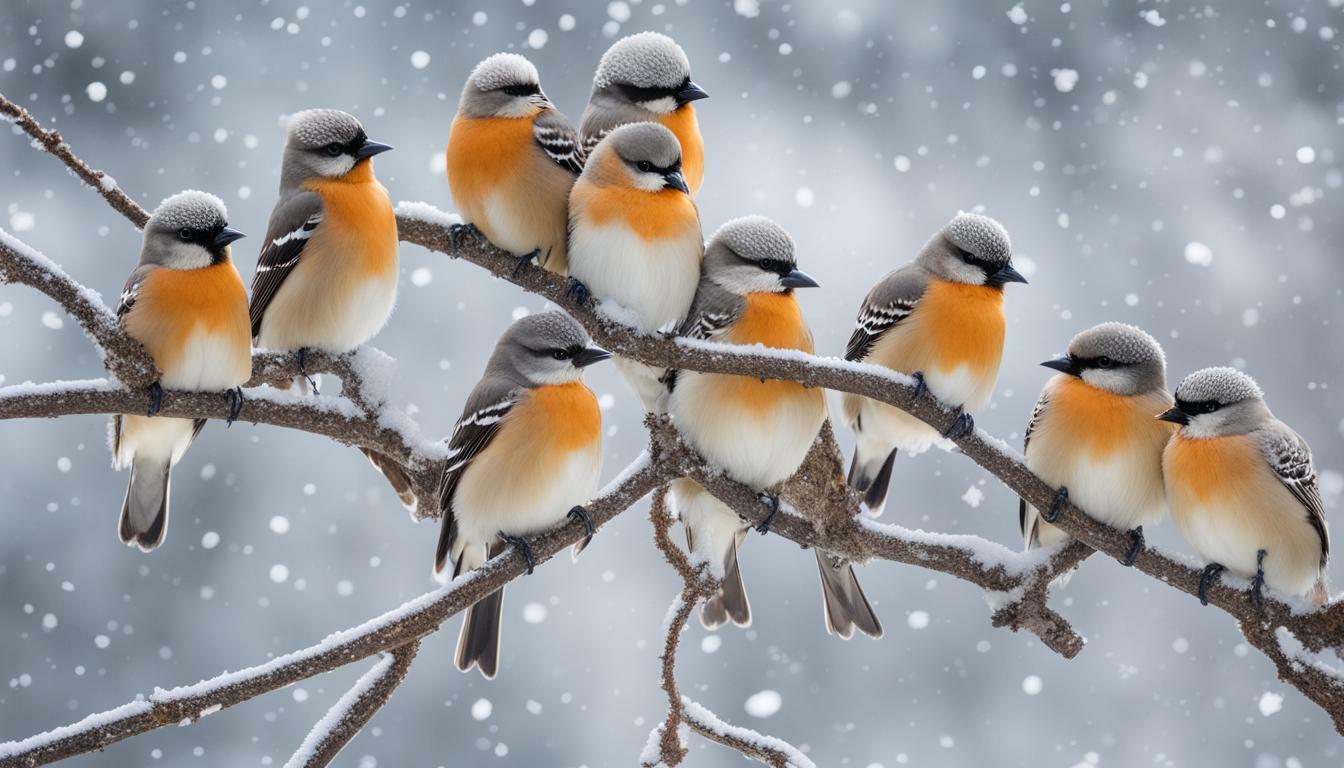Have you ever wondered if birds get cold? As the temperature drops, you may see birds fluff up their feathers, and you may wonder if they are feeling the chilly weather. In this section, we will explore the topic of whether birds get cold and how they adapt to winter conditions.
Birds have a range of cold tolerance, and their ability to withstand cold temperatures differs between species. Some species have developed unique adaptations to survive in harsh winter conditions, while others migrate to warmer climates. Let’s dive into the world of bird temperature regulation and adaptation to winter.
Key Takeaways:
- Birds have varying levels of cold tolerance.
- Some bird species have unique adaptations to survive in cold temperatures.
- Other bird species migrate to warmer climates during the winter months.
Avian Thermoregulation: Understanding Bird Body Temperature Regulation
Have you ever wondered how birds are able to survive in cold weather? In this section, we will explore how birds regulate their body temperature through a process known as avian thermoregulation.
Unlike mammals, birds have a much higher internal body temperature. While human body temperature hovers around 98.6°F (37°C), birds maintain a body temperature of around 105°F (40°C). This high body temperature helps birds maintain warmth even in freezing temperatures.
Birds have a variety of physiological adaptations that aid in thermoregulation. One such adaptation is their feathers. Feathers provide insulation by trapping warm air close to the bird’s body. The down feathers, located closest to the skin, are particularly effective at trapping heat and keeping birds warm.
In addition to feathers, birds also have the ability to constrict or dilate blood vessels in their legs to regulate heat loss. When a bird’s legs are exposed to cold air, the blood vessels constrict, reducing the amount of heat lost through the skin. Conversely, when the bird’s legs become too warm, the blood vessels dilate, increasing heat loss and helping the bird cool down.
Birds also have the ability to increase their metabolism to generate heat. This is particularly important during cold weather when external heat sources are limited. By increasing their metabolic rate, birds are able to produce more heat and maintain their body temperature.
Avian Thermoregulation Behaviors
Birds also exhibit a variety of behaviors that aid in thermoregulation. For example, many birds huddle together in groups to conserve heat. By standing close together, birds can share body heat and maintain warmth, even in freezing temperatures.
Another thermoregulation behavior exhibited by birds is sunning. Birds will perch in a sunny spot and spread their wings to absorb heat. This helps to raise their body temperature and maintain warmth.
In conclusion, birds possess a variety of unique adaptations and behaviors that aid in avian thermoregulation and enable birds to survive in cold weather. By understanding these mechanisms, we can better appreciate the remarkable ability of birds to thrive in even the harshest of conditions.
Bird Winter Adaptation: How Birds Cope with Chilly Temperatures
Winter can be a challenging time for birds, but many species have developed remarkable strategies to survive in cold weather.
Birds adapt to winter in a variety of ways, such as changing their diets to include more high-energy foods like seeds and nuts, and fluffing up their feathers to create insulating air pockets. Some birds, like chickadees, even lower their body temperature at night to conserve energy.
Migration is another common winter adaptation for many bird species. They travel to areas with more favorable climates and abundant food sources, returning to their breeding grounds in the spring.
But not all birds migrate. Some species, like the tough little chickadee, stay put and rely on other strategies to survive. For example, they may huddle together in communal roosts to share body warmth or seek shelter in dense evergreen trees that provide protection from the wind.
Other birds, like woodpeckers and nuthatches, store food during the fall to eat during the winter months when food is scarce. And some species, like the northern shrike, have adapted to become carnivorous during the winter, preying on other birds and small mammals.
Overall, birds have an incredible ability to adapt to changing winter conditions. Through physiological changes, behaviors, and clever strategies, they are able to cope with cold temperatures and find the resources they need to survive.
Bird Cold Tolerance: Investigating the Limits of Bird Winter Survival
Birds have evolved various mechanisms to help them cope with cold temperatures during winter. Some species possess impressive cold tolerance and can withstand freezing temperatures that would be lethal to humans.
Their feathers are one of the most remarkable adaptations for cold weather survival. Birds have a unique feather structure that is highly efficient at trapping heat. The down feathers, located closest to the skin, provide the most insulation and serve as a barrier between the bird’s body and the frigid air.
Birds also possess specialized circulatory systems that help to prevent heat loss. A bird’s legs, for example, contain a network of blood vessels that act as a heat exchanger. Warm blood from the bird’s body flows to the feet, where it can be cooled before returning to the body. This system helps to conserve heat and keep the bird warm.
Some birds also exhibit a phenomenon called torpor, which is a state of decreased physiological activity. During torpor, the bird’s body temperature drops significantly, enabling it to conserve energy and survive harsh conditions. Some species can even enter a state of hibernation, which is a more prolonged form of torpor.
Birds that live in extremely cold regions have evolved additional strategies for survival. For example, some species have developed unusually thick bills that help them dig through snow to find food. Others have increased their fat stores to provide an additional source of insulation.
Overall, birds’ remarkable adaptations for cold weather survival are a testament to their tenacity and resilience. These unique features allow them to thrive in even the harshest winter conditions, making them an integral part of the ecosystem.
Bird Cold Tolerance: Investigating the Limits of Bird Winter Survival
As we explored earlier in this article, birds have developed unique adaptations to regulate their body temperature and cope with winter conditions. But what are the limits to which birds can survive in extreme cold weather?
Birds have varying levels of cold tolerance depending on their species and habitat. Some species, such as the peregrine falcon, can withstand temperatures as low as -50°F. Other species, like the common pigeon, have a lower cold tolerance and may not survive prolonged exposure to freezing temperatures.
However, even birds with high cold tolerance must conserve energy and find ways to maintain warmth in order to survive. Some birds, such as chickadees, fluff up their feathers to create an insulating layer of air that keeps them warm. Others, like snow buntings, huddle together in large groups to share body heat.
Bird Winter Survival Mechanisms
Many bird species have developed unique mechanisms to survive in cold weather. For example, some species have the ability to decrease their metabolic rate during periods of food scarcity, conserving energy and allowing them to survive for longer periods without food.
Migratory birds also have developed fascinating adaptations to survive winter. Some species, like the arctic tern, migrate to warmer climates during the winter months to avoid the harsh conditions. Others, like the snowy owl, travel southward only in years when food is scarce in their northern territory.
Do Birds Feel Cold? How Birds Respond to Chilly Temperatures
While birds have developed impressive adaptations to survive in cold weather, you might be wondering: do they feel cold?
The answer is not quite straightforward. Birds have a different physiological response to temperature than humans do, and they may not feel cold in the same way we do. However, they can still experience discomfort and be affected by prolonged exposure to freezing temperatures.
When birds do feel cold, they may exhibit behaviors such as shivering to generate body heat, or seeking shelter in protected areas like birdhouses or tree cavities. Some species also change their diet in the winter, switching to high-fat foods that provide more energy to keep them warm.
Conclusion
Overall, birds have developed fascinating adaptations to cope with chilly temperatures and survive in the winter. While they may not feel cold in the same way humans do, they can still experience discomfort and must conserve energy to maintain warmth. By understanding how birds regulate their body temperature and adapt to winter conditions, we can better appreciate their resilience and survival strategies.
Can Petting Birds Affect Their Body Temperature?
Many people wonder about the impact of petting on birds’ sexual behavior when being pet. While petting birds can stimulate them and foster a bond with their owners, it does not directly affect their body temperature. However, it is crucial to handle birds gently and respect their boundaries to maintain their emotional well-being.
Does Feathers Falling Out during Molting make Birds Cold?
Feathers falling out during molting is a natural process for birds regrowing feathers. While it may seem like they would get cold without their feathers, birds have an amazing adaptation. They can adjust their metabolic rate to generate heat and are also equipped with down feathers that provide insulation, keeping them warm during this renewal phase.
FAQ
Q: Do birds get cold?
A: Yes, birds can experience cold temperatures. However, they have unique physiological adaptations and behaviors that help them tolerate and survive in chilly conditions.
Q: How do birds regulate their body temperature?
A: Birds regulate their body temperature through various mechanisms. They fluff up their feathers to trap heat, shiver to generate warmth, and adjust their metabolic rate. Additionally, some species can lower their body temperature during periods of rest.
Q: How do birds adapt to winter?
A: Birds have developed several adaptations to cope with winter. These include changing their migration patterns, forming flocks for better protection, growing thicker feathers, and seeking out food sources in different locations.
Q: How cold can birds tolerate?
A: Birds have different levels of cold tolerance depending on their species and physiological adaptations. Some birds can tolerate extreme cold temperatures, while others may seek refuge in warmer areas or go into a state of torpor.
Q: Can birds feel cold?
A: While birds can sense changes in temperature, their perception of cold may be different from humans. They have effective ways of staying warm and regulating their body temperature, so they may not experience cold in the same way we do.











